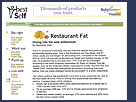

|
||||
| “Dining Into the New Millennium” by Stephanie Gold The U.S. economy is booming, and our collective weights and girths are exuberantly keeping pace. One in five Americans are now obese, and 97 million adults are overweight--an astounding 55%, compared to the modest 25% of 1975—as reported by the National Health and Nutrition Survey. At this rate, it’s predicted that by the year 2025, 75% of us will be overweight, according to the North American Association for Study of Obesity. And yet, studies, such as the American Dietetic Association's survey, Nutrition and You: Trends 2000, indicate that more people are nutrition conscious than ever before. How can these divergent trends be reconciled? In a word, restaurants. The USDA confirms that significantly more food is now consumed out, and of the food eaten at home, more is coming from pizza boxes and take-out cartons. Consider these USDA statistics:
More people may conscientiously use nutrition labels to buy low-fat ingredients for home, but eating out is clearly different. It’s not coincidental that dining out is up while unemployment is down. With more people working, time to shop for food, let alone prepare a meal, is becoming one of the few luxuries we can’t afford. More than twice as many married women work now compared to 40 years ago, single-parent family rates are steadily rising, and commutes are longer. So who wants what on their pizza tonight? Why does eating out necessarily entail gaining weight? One culprit is the fast-food emporium. As Mary Mead, UC Berkeley Lecturer and Director of Berkeley’s School of Public Health Dietetic Internship Program points out, “Fast food is fast because it’s fried, and that means more fat, more absorption of oil.” Says Mead, “Fat makes food taste good. So a little more fat and sodium will make the consumers happier with what they’re eating.” If not in the long run, when they weigh in, then in the immediate gratification of the moment, as they scarf their cheeseburgers and fries. Portion size is another issue where economy combines with psychology to make your jeans too tight. Joanne Ikeda, UC Berkeley Nutritional Sciences Lecturer and Nutrition Education Specialist, explains the process. “For 39 cents, you get double the size of everything,” she says. “It’s ridiculous. If it only costs a few more cents to get the super size fries and coke, you don’t think ‘oh my god, I don’t want twice as much food.’ You go ‘Wow! What a good deal!’” Then, since you don’t want to waste, you clean your plates like good scouts, hungry or not. You may make mom proud when you polish off titanic helpings, but you’re not doing yourself any favors. Biing-Hwan Lin, USDA Economist and co-author of Eating Out in America, factors in finances. “In the U.S., the ingredients are relatively cheap and labor is expensive. Restaurants make money by offering bigger portions, and consumers are happy because they’re getting their money’s worth.” Suggests Lin, “If we’re genuinely interested in improving our diet, when we go out to eat, we should order healthy dishes, or take some home for the next meal.” Easy for him to say, but when you’re on a date or a business luncheon, who’s going to ask for a doggie bag? Even casual dining has its pitfalls. Eating out is meant to be fun; it’s not when we want to focus on dietary restrictions. There are social pressures, too. You may fear the wet-blanket sobriquet if you nix an appetizer or dessert. And wine does more than add calories to your meal. It slows your metabolism down and it impairs your decision-making abilities. More buttered mashed potatoes? Why not. It’s appealing to blame the restaurants. If they made healthier dishes and smaller portions, dining out wouldn’t be such a calorie glut. But when restaurants offer heart-healthy entrees, most patrons skim right on past to the fettuccine Alfredo. “Taco Bell offered some healthy items, and they couldn’t sell,” Lin recalls, “so Taco Bell yanked them out. What consumers say is one thing, but whether they do it or not, that’s a very different story.”
|
||||
